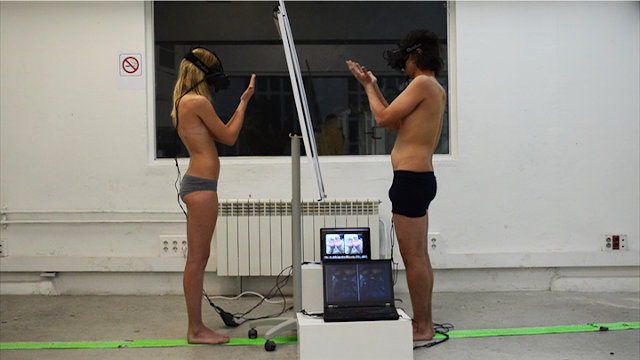Talk about going on a gender bender.
A new machine created by a Spanish design collective combines virtual reality with advanced neuroscientific techniques to let men and women swap bodies with each other. Called The Machine To Be Another, it's all done in the hopes that body transference will help scientists explore and quantify concepts like sexism, gender identity, and bias.
Based in Barcelona, Be Another Lab is made up of Philippe Bertrand, Daniel Gonzalez Franco, Christian Cherene, and Arthur Pointea, a collection of interdisciplinary artists whose fields range from programming and electronic engineering to interactive system design and neuro-rehabilitation. Together, the goal of Be Another Lab is to explore the concepts of empathy through technology, science, and art.
In most neuroscience experiments that examine issues of empathy and bias, participants "trade places" with others using digital avatars. If a study wants to explore empathy for the handicapped, for example, scientists might sit subjects down in front of a computer and make them play a video game in which they are confined to a wheelchair, then ask them a series of questions about how the experience made them feel. But none of it is real.
Be Another Lab takes a different, more visceral approach to exploring empathy. Instead of using digital avatars, the group uses performers to copy the movements of a subject: for example, racial bias is studied by having a subject's actions mirrored by a performer of color.
"We believe this allows for a deeper experience for a user, knowing that their point of view is that of an actual human being, and not a virtual avatar," says Bertrand. "In the last year, we've observed that subjects tend to demonstrate empathetic feelings towards the performers they didn't have before. They say that the experience has raised their awareness about the performers' social conditions, that they were able to go 'deep into this other person's life.'"
With The Machine To Be Another, Bertrand and company have taken this approach to the next level by leveraging the tech of a paid Oculus Rift virtual reality headset. In the project, two participants stand in front of one another, and put on their headsets which allow them to effectively see out of one another's eyes. When they look at each other, they see themselves. When they speak, they hear the other person's voice in their ears.

But this isn't where the simulation ends. Working together, the two participants are encouraged to sync their movements, touching objects in the room, looking at things, and exploring their 'own' bodies simultaneously.
"The brain integrates different senses to create your experience of the world," explains Bertrand. "In turn, the information from each of these senses influences how the other senses are processed. We use these techniques from neuroscience to actually affect the psychophysical sensation of being in your body."

In other words, in combination with being fed video and sound from their partner's headset, by moving and touching things at the same time, the Machine To Be Another can actually convince people that they are in someone else's body as long as the two partners remain in sync.
It's a radical idea that Be Another Lab is only beginning to explore. Right now, their experiments have mostly focused on gender swapping, which the team hopes will also explore issues in regards to transgender and queer bias. The group is currently looking to partner with organizations, experts and activists to help them further perfect their techniques.
They say to truly understand someone, you have to walk a mile in their shoes. Thanks to the Machine To Be Another, you won't just walk that mile, you'll feel the blisters on the other person's feet.